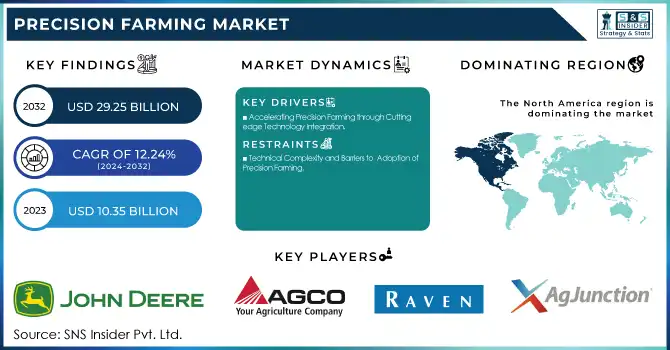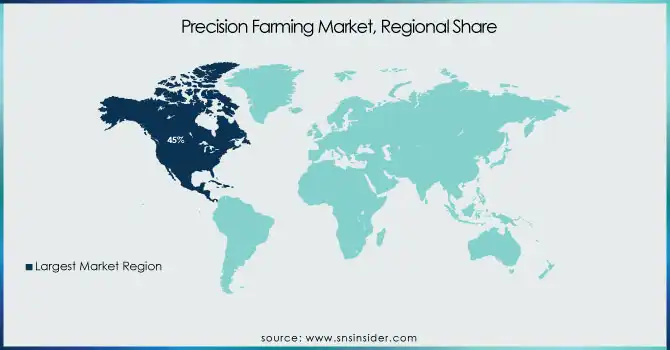Precision Farming Market Size & Trends:
The Precision Farming Market Size was valued at USD 10.35 billion in 2023 and is expected to grow to USD 29.25 billion by 2032 and grow at a CAGR of 12.24% over the forecast period of 2024-2032. Rapid adoption of various advanced technology for lowering labor cost and improving productivity along with growing usage of Internet of Things (IoT) devices in agriculture has been some of the major contributors to the growth of this market. Precision farming provides considerable cost efficiencies and is regarded as an important way to meet climate change challenges and growing food demands. Furthermore, government support and incentives for adopting precision farming practices are accelerating its global adoption, making it an essential part of modern agriculture.

Get E-PDF Sample Report on Precision Farming Market - Request Sample Report
Precision Farming Market Dynamics
Drivers:
-
Accelerating Precision Farming through Cutting-edge Technology Integration
The adoption of advanced technologies such as GPS, IoT, AI, drones, and laser cutting is revolutionizing the precision farming market by enhancing operational efficiency, lowering labor costs, and optimizing crop management. hese advancements allow for the monitoring of soil quality, climate conditions, and crop health in real-time, making it easier to make informed decisions and improve the use of resources. Tasks such as crop scouting and irrigation are being automated with the help of technologies such as AI and drones, while laser cutting improves farm equipment manufacturing processes. With an increasing number of technologies being implemented in agriculture, the need for precision farming solutions is more present than ever, a result of sustainability needs and demand for increased productivity in the sector. This technological shift is expected to gain momentum as farmers look for smarter, more cost-effective ways to meet the rising global food demand.
Restraints:
-
Technical Complexity and Barriers to Adoption of Precision Farming
Advanced precision farming technologies like GPS, IoT, AI, and drones, used to integrate and effectively use them in farming, are challenged by their technical complexity. Numerous farmers, particularly in rural environments, do not have the expertise required to operate these technologies properly. The USDA estimated that 27% of U.S. farms had adopted precision agriculture practices in 2023—with even higher adoption rates for corn (72%) and soybean (70%). Adoption rates are also influenced by regional factors like farm size and crop type, with the Midwest showing higher adoption due to better access to technology and support. Overcoming the learning curve and the need for specialized knowledge is crucial for widespread adoption.
Opportunities:
-
Technological Development in Precision Farm Unlocking Growth Potential
Precision farming uses real-time data, including weather and soil health information, to enhance crop production by enabling more accurate farming decisions. It is expected to surpass traditional agricultural practices, with mobile apps allowing remote monitoring and equipment management through communication systems. Technologies such as variable rate technologies (VRT) enable more efficient application of seeds, fertilizers, and other resources. North America leads the adoption of IoT, big data, drones, and robotics in agriculture, though high costs still pose challenges for small-scale farmers. However, innovations in driverless tractors, GPS sensing systems, and controlled traffic systems (CTF) are anticipated to lower costs and enhance crop quality, creating significant growth opportunities for the precision farming market.
Challenges:
-
Connectivity issues, including poor 4G/5G access and slow broadband, limit precision farming adoption and hinder real-time data use.
Although broadband speeds are improving, 6% of members do not have any access to 4G or 5G on their phones and only 58% of members report that the internet speeds available to them are sufficient for their farm operations. Dependable connectivity is essential for everything from using GPS on tractors, VAT returns, and communicating with customers. In 2023, only 27% of U.S. farms used precision agriculture techniques to manage crops and livestock. Even though precision farming tools like IoT, drones, and GPS systems depend on a constant stream of data for optimal performance; limited or inconsistent Internet availability in rural areas prevent such tools from realizing their best results. The Federal Communications Commission (FCC) highlights that inadequate infrastructure is a key barrier to precision farming’s growth, making overcoming connectivity issues essential for enhancing agricultural productivity and sustainability.
Precision Farming Market Segmentation Analysis:
By Offering
Based on Offering, Hardware segment is dominating in Precision Farming Market of around 55% in 2023. The emergence of advanced hardware technologies, including GPS systems, sensors, drones, automated machinery, and driverless tractors is one of the key factors that has contributed to the growing usage of precision agriculture. These devices are essential for precision irrigation, monitoring soil health, and filtering crop yields. This also supports technologies such as variable rate application (VRA) and controlled traffic (CTF) systems, both critical to target resource management. As the demand for more accurate and efficient farming practices grows, hardware solutions continue to play a crucial role in shaping the future of precision agriculture, contributing significantly to market growth.
The software segment is expected to experience the fastest growth in the precision farming market from 2024 to 2032, driven by increasing demand for data analytics, artificial intelligence (AI), and cloud-based platforms. Software solutions like farm management systems, weather prediction tools and crop monitoring applications are emerging in gaining market, which are able to process data from IoT devices and drones. These tools offer practical recommendations for farmers to maximize crop production, elevate resources efficiency, and boost sustainability. Further, AI and machine learning are being used for predictive analytics, allowing farmers to predict weather patterns, pest invasions and soil conditions. As farming becomes increasingly data-driven, software solutions are playing a key role in enhancing decision-making and driving operational efficiencies, fostering market expansion in the long term.
By Application
The Yield Monitoring segment dominated the precision farming market with a 40% share in 2023, due to its ability to provide farmers with real-time data on crop performance throughout the harvest. This part is about typically on farm and off farm yield tracking. In this regard, on-farm yield monitoring helps to promote operational efficiency through real-time data collection and as the basis of spatial database. These features contribute to the segment’s dominance, as they help farmers optimize inputs, reduce waste, and make informed decisions that enhance overall farm productivity and profitability.
Irrigation Management is expected to be the fastest-growing segment in the precision farming market from 2024 to 2032, driven by the need for more efficient water usage in agriculture. due to its ability to provide farmers with real-time data on crop performance throughout the harvest. This part is about typically on farm and off farm yield tracking. In this regard, on-farm yield monitoring helps to promote operational efficiency through real-time data collection and as the basis of spatial database. As climate change and water conservation become increasingly important, demand for advanced irrigation management solutions is poised for rapid growth.
Precision Farming Market Regional Landscape:
North America holds a dominant share of around 45% in the precision farming market as of 2023, driven by widespread adoption of smart agricultural technologies and strong support from government initiatives. The region, particularly the U.S. and Canada, leads in the use of IoT, GPS, drones, and robotics for farming. Large-scale farms in the Midwest benefit from precision tools for yield monitoring, irrigation management, and crop health monitoring. The presence of major tech companies and continuous investments in agriculture-focused innovations further contribute to North America's market leadership. Additionally, the region's high level of infrastructure development and favorable policies enhance the adoption of precision farming technologies, positioning it as a key player in the global market.
Asia-Pacific is expected to be the fastest-growing region in the precision farming market during the forecast period from 2024 to 2032. The growth is driven by rapid technological advancements along with the growing adoption of IoT, AI, and drone technologies to agriculture and the increasing demand for environmentally sustainable farming practices to meet the growing food demand in the region. India, China, and Japan have been heavily investing in precision farming solutions to increase crop yields, optimize resource use, and strengthen food security. Government initiatives and subsidies for modern agricultural practices are fostering the growth of precision tools within the agricultural sector. Asia Pacific is expected to witness considerable growth over the forecast period, attributed to the extensive agricultural base and the need for productivity improvement.

Get Customized Report as Per Your Business Requirement - Request For Customized Report
Market Key Players
Some of the major key Players in Precision Farming Market along with their product:
-
Deere & Company (US) – (John Deere Precision Agriculture Solutions)
-
AGCO Corporation (US) – (Fuse Technologies)
-
Raven Industries, Inc. (US) – (Raven Applied Technology)
-
AgJunction LLC (US) – (AgJunction Solutions)
-
Trimble Inc. (US) – (Trimble Ag Software and Hardware)
-
Ag Leader Technology (US) – (Ag Leader Precision Farming Products)
-
CropMetrics LLC (US) – (CropMetrics Precision Irrigation)
-
Topcon Corporation (Japan) – (Topcon Precision Agriculture)
-
AgEagle Aerial Systems Inc. (Agribotix LLC) (US) – (Agribotix Drone Solutions)
-
DICKEY-john Corporation (US) – (DICKEY-john Precision Ag Equipment)
-
Farmers Edge Inc. (Canada) – (Farmers Edge Precision Farming Solutions)
-
Grownetics, Inc. (US) – (Grownetics Precision Ag Technology)
-
Proagrica (SST Development Group, Inc.) (UK) – (SST Software Solutions)
-
The Climate Corporation (US) – (Climate FieldView)
List of Suppliers who provide raw material and component in Precision Farming Market:
-
BASF (Germany)
-
Dow Chemical (US)
-
Syngenta (Switzerland)
-
Monsanto (now part of Bayer) (US)
-
Nutrien (Canada)
-
Mosaic Company (US)
-
Yara International (Norway)
-
Cargill (US)
-
Valmont Industries (US)
-
Trelleborg (Sweden)
-
ExxonMobil (US)
-
Vestas (Denmark)
-
Danfoss (Denmark)
-
SABIC (Saudi Arabia)
-
Linde Group (Germany)
Recent Development
-
January 20, 2025: John Deere “Robotics, AI and advanced machinery will drive greater efficiency in farming” continues to enhance its precision agriculture capabilities, having secured five new technology patents The patents demonstrate the company's dedication to innovation, underpinning its dominance in the digital farming sector.
-
April 1, 2024: AGCO Corporation and Trimble have announced that their joint venture agreement establishing PTx Trimble has been completed and is effective The JV integrates Trimble's precision ag business with AGCO's JCA Technologies to deliver a mixed-fleet precision Ag platform to farmers worldwide with next-gen tools for productivity and sustainability. AGCO takes an 85% stake and Trimble keeps 15%.
| Report Attributes | Details |
| Market Size in 2023 | USD 10.35 Billion |
| Market Size by 2032 | USD 29.25 Billion |
| CAGR | CAGR of 12.24 % From 2024 to 2032 |
| Base Year | 2023 |
| Forecast Period | 2024-2032 |
| Historical Data | 2020-2022 |
| Report Scope & Coverage | Market Size, Segments Analysis, Competitive Landscape, Regional Analysis, DROC & SWOT Analysis, Forecast Outlook |
| Key Segments | • By Offering (Hardware, Software, Services) • By Application (Yield Monitoring, Field Mapping, Crop Scouting, Weather Tracking & Forecasting, Irrigation Management, Inventory Management, Farm Labour Management) |
| Regional Analysis/Coverage | North America (US, Canada, Mexico), Europe (Eastern Europe [Poland, Romania, Hungary, Turkey, Rest of Eastern Europe] Western Europe] Germany, France, UK, Italy, Spain, Netherlands, Switzerland, Austria, Rest of Western Europe]), Asia Pacific (China, India, Japan, South Korea, Vietnam, Singapore, Australia, Rest of Asia Pacific), Middle East & Africa (Middle East [UAE, Egypt, Saudi Arabia, Qatar, Rest of Middle East], Africa [Nigeria, South Africa, Rest of Africa], Latin America (Brazil, Argentina, Colombia, Rest of Latin America) |
| Company Profiles | Deere & Company (US), AGCO Corporation (US), Raven Industries, Inc. (US), AgJunction LLC (US), Trimble Inc. (US), Ag Leader Technology (US), CropMetrics LLC (US), Topcon Corporation (Japan), AgEagle Aerial Systems Inc. (Agribotix LLC) (US), DICKEY-john Corporation (US), Farmers Edge Inc. (Canada), Grownetics, Inc. (US), Proagrica (SST Development Group, Inc.) (UK), The Climate Corporation (US). |

